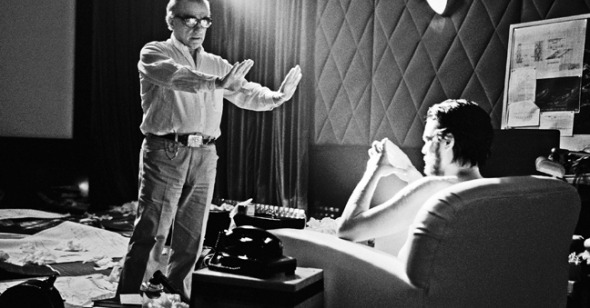When hearing the name Martin Scorsese, it’s unlikely that two people in the same room will immediately conjure the same feeling. Some might think immediately of grit—as in Taxi Driver’s nighttime prowls or Raging Bull’s domestic squabbles. For others, it’s grandeur—the delicate sweep of Michelle Pfeiffer’s hand fan across the expanse of an opera house in The Age of Innocence or the climactic revelation on the cross in The Last Temptation of Christ.
Or maybe it’s not a moment at all, but a pattern. Looking back over the peaks and valleys of his oeuvre, one is less inclined to identify discrete epochs and movements (like, perhaps, one does with his contemporaries Coppola and Spielberg) than to see the ebbs and flows of an artist fueled by an insatiable curiosity. Who else would have followed up the profoundly disturbing plunge into jealousy and grotesque violence that was Casino with the stirring expressionism of Kundun, a film about nonviolent resistance? We see no contradiction or hypocrisy in the gap between these two films, but instead a bridge, connecting two disparate artistic manifestations of Scorsese’s morality.
Scorsese has offered no shortage of extraordinary standalone scenes and images, but often it’s the complex overall design of his films that is so unusually striking. With the aid of incredible artists in the shadows like Thelma Schoonmaker, Michael Ballhaus, László Kovács, and Paul Schrader, many of his movies, such as Goodfellas and Casino and The Wolf of Wall Street become crazy quilts of American excess; New York, New York and Life Lessons and The King of Comedy are compelling, even frightening examinations of the terrors and anxieties of human interaction. He’s as nimble at sketching interior worlds of solitary outsiders as he is at creating wide-ranging surveys of social landscapes.
But the question of what we think of when we think of Scorsese is a much larger, confusing one. Once he was seen, reductively but not inaptly, as the preeminent chronicler of Italian-American Catholic guilt. Now that seems merely a starting point. Of late, his work as a preservationist and as an all-purpose guru for the legacy of world cinema itself—his 1981 campaign against the looming issue of fading color stock, which got the attention of Eastman Kodak; his heroic World Cinema Foundation, which rescues and preserves films from around the world; his various documentaries charting his personal journeys through film, which make him something like American cinema’s more scholarly, less radical Jean-Luc Godard—has somewhat overshadowed his directorial career. His generosity in giving interviews and making appearances to talk about other filmmakers’ work has resulted in him becoming perhaps the American film industry’s most recognizable, omnipresent artist—a walking, talking personification of cinema itself.
As he’s reached these heights of visibility, he’s gone the opposite route of so many great film auteurs (Godard, Kubrick, Woody Allen) whose personalities become more remote and irascible as they age. It’s been an unlikely transformation: from the redoubtable little firebrand of the New American Cinema to the cuddly twinkle-in-his-eye pusher of classics. He is driven to keep moviemaking alive, especially in these times of radical change. It’s hard not to be charmed. Even as he publicly rails against the dying of the form’s light he continues to find exciting ways to use its latest technologies—as seen in Hugo, which put silent, turn-of-the-twentieth-century cinema and twenty-first-century razzle dazzle on the same magic plane. In other words, he still excites us because he still seems to be excited—by telling stories and by the possibilities of the medium. And in the wake of the primal screen of The Wolf of Wall Street, he seems as vital as ever.
Scorsese stands apart from other American directors to whom we’ve devoted career symposiums at Reverse Shot. He’s not a cult director with a rabid following like Brian De Palma; he’s not a divisive Hollywood figure like Steven Spielberg; he doesn’t have that homegrown, idiosyncratic aura like such indie-bred filmmakers as Richard Linklater and Jim Jarmusch. He is a director whose talents and appeal most people seem to agree upon, from casual movie-watchers to die-hard cinephiles. But, for such an icon, Scorsese is fairly tricky to pin down. What threads, if any, connect his various, distinctive films? Is he more fascinating a director because of commonalities between his films or divergences? Should one focus more on his thematic inquiries or his technical mastery? Just what is it that underlies his across-the-board adoration, and are there reasons to be wary of it?
In these articles, we will trace the arc of his career, from his NYU shorts through his early independent features to his long stretch of ups and downs working within Hollywood. These articles examine his films in industrial, ideological, thematic, and biographical ways, and taken cumulatively will hopefully help us arrive at a better working definition of just who this extraordinary director is, and how he has managed to make such a uniquely personal American cinema.
